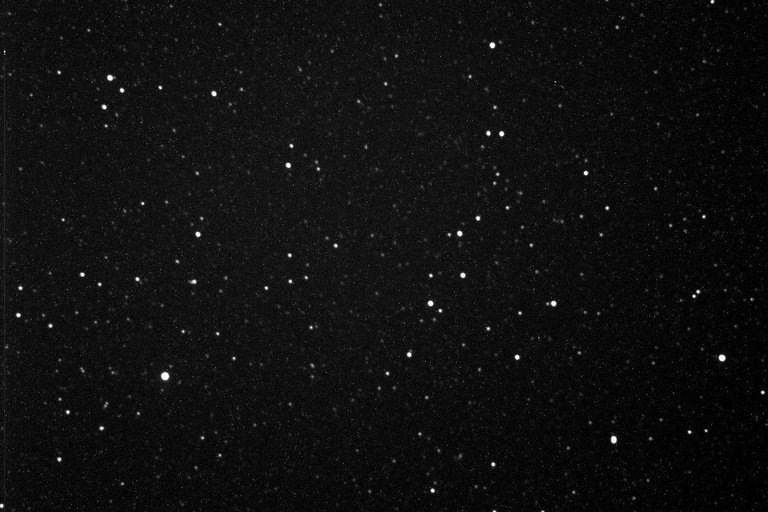Image calibration is simply the removal of the anomalies from the camera sensor and imperfections in the optical pathway. When taking astronomical pictures, this helps make the image "pretty." When doing photometry, it is essential in order to get accurate scientific data on the number of photons collected. One of the priorities of TECMO is to generate solid calibration frames in order to increase the quality of its photometric observations.
Below is a raw picture of the star field for the variable EM Cyg.

There are 3 basic types of calibration that must be performed to achieve the intended results:
- Bias frame
- Dark frame
- Flat field
- Light images are the raw images that will be taken of the astronomical objects. These are the images that will be calibrated.
These are sometimes collectively referred to as BDF calibration. Let's start with bias frames. These are zero-length exposures used to uncover the small errors that cause a pixel to start at a value higher than 0 (Covington 2007). These errors can be caused by the noise from the electronics in the set-up, including the CCD camera and interference from the computer. Bias frames should be taken at the same temperature as the light images will be taken and with the telescope's cap on. To create a Master Bias frame, take around 100 images and then average them together using image processing software. The Master Bias should be replaced any time the temperature of the light frames changes or a component of the set up (i.e., computer) changes.
Master Bias. Here is the Master Bias at 0 degrees Celsius for TECMO:

Next is dark frames. Dark frames account for the thermal noise in the CCD chip. This noise manifests as "hot pixels" in the image. Dark frames are also taken with the telescope cap on and at the same (or nearly the same) temperature as the light images will be taken. It is also better to take these images in the dark to prevent any unwanted light from leaking in. Unlike the bias frames, dark frames should be taken at the same exposure time (or longer) as the light images. Take 30 or more dark frames and then average them to generate a Master Dark.
Master Dark. Here is the Master Dark at 0 degrees Celsius, 60 second exposure for TECMO. The white dots are hot pixels. For an ideal chip that had no thermal noise, the image would be totally black:

Flat fields are the hardest calibration component to complete. The idea is to compensate for the variations of light intensity and dust specks in the optical path (Howell 2006). Therefore, to create a flat field, an image is take of a uniform light source so that the pixel-to-pixel variations will be recorded. Then when a light image is taken, it can be divided by the values of this calibration image to "flatten" it. However, the difficulty lies in finding a uniform light source. TECMO's method is to take exposures at twilight with a white tshirt stretched across the front of the telescope aperture. Flats must be taken for every filter that will used for light images. Take around 20 images for each filter, average, and subtract the Master Dark to create the Master Flat. The Master Flat should ideally be updated weekly to account for dust build up in the system.
Master flat. Here is the Master Flat for TECMO's V filter at 0 degrees Celsius, 5 second exposure. Notice the 2 dust "doughnuts" and the dark vignetting around the edges:

Final Product: Below is a raw image of the variable EM Cyg alternating with the BDF calibrated image. You will notice the removal of many tiny "hot" pixels as well as the "flattening" of the dark vignetting around the edges revealing some stars that were previously hidden in the noise.

References
- Covington, M. A. 2007, Digital SLR Astrophotography, Cambridge University Press, UK
- Howell, S. B. 2006, Handbook of CCD Astronomy, Cambridge University Press, UK
If you have all photos taken with the same time, you don't need take bias frames, becouse bias noise is in dark frame.
Good point